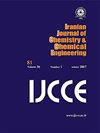Sonochemically synthesized mesoporous pyrophanite- MnTiO3/TiO2 nanoparticles: An Adsorbent for removal of commercial Malachite green dye
IF 1
4区 工程技术
Q4 CHEMISTRY, MULTIDISCIPLINARY
Iranian Journal of Chemistry & Chemical Engineering-international English Edition
Pub Date : 2021-09-26
DOI:10.30492/IJCCE.2021.522355.4500
引用次数: 0
Abstract
Malachite green (MG) dye belongs to the triphenylmethane class, extensively employed in textile industries and its presence in aqueous environment exhibits a noxious impact on living beings. Thus, it’s being immensely important to remove the dye/residues from the environment matrix. Herein, the sonochemical synthesized adsorbent material -pyrophanite-MnTiO3/TiO2 nanoparticles (NPs) was utilized to expel the commercial Malachite green (MG) dye from the solution. The adsorption efficacy data indicates the maximum removal of MG (90.2%) is obtained for the NPs calcinated at 1000 °C (MT1). The adsorption material (MT1) is characterized by using different techniques including XRD, FE-SEM, EDX, FTIR, BJH, and BET. The XRD analysis indicates the formation of divergent phases viz. rutile TiO2 and MnTiO3. The FE-SEM depicts the formation of a nano-rod-like structure. The average size and percentage of void space of MT1 NPs are evaluated by using IMAGE J software. The hysteric loops from BET and BJH plots revealed the existence of type H3 hysteresis, confirming the mesoporous structure for MT1 NPs. The surface area, pore-volume, and pore size are found to be 61.245 m2/g, 0.139 cm3/g, and 2.0178 nm respectively. The pH, dye concentration, and temperature of the solution are optimized for the maximum removal of MG using MT1 NPs. Further, the adsorption isotherms, kinetics studies, and intra-particle studies indicative of the existence of monolayered second-order diffusion onto the surface of MT1 NPs. The adsorption process is endothermic, thermodynamically driven, and accompanied by an increase in entropy.声化学合成介孔焦磷矿- MnTiO3/TiO2纳米颗粒:去除商用孔雀石绿色染料的吸附剂
孔雀石绿(MG)染料属于三苯甲烷类,广泛应用于纺织工业,其存在于水环境中对生物产生有害影响。因此,从环境基质中去除染料/残留物是非常重要的。本文利用声化学合成的吸附剂-焦啡石- mntio3 /TiO2纳米颗粒(NPs)从溶液中去除商业孔雀石绿(MG)染料。吸附效果数据表明,在1000°C (MT1)下煅烧的NPs对MG的去除率最高(90.2%)。采用XRD、FE-SEM、EDX、FTIR、BJH、BET等技术对吸附材料MT1进行了表征。XRD分析表明形成了金红石型TiO2和MnTiO3相。FE-SEM表征了纳米棒状结构的形成。利用IMAGE J软件对MT1 NPs的平均尺寸和空隙率进行了评价。BET和BJH图的滞回环显示了H3型滞回的存在,证实了MT1 NPs的介孔结构。比表面积、孔体积和孔径分别为61.245 m2/g、0.139 cm3/g和2.0178 nm。对溶液的pH、染料浓度和温度进行了优化,以最大限度地利用MT1 NPs去除MG。此外,吸附等温线、动力学研究和颗粒内研究表明,MT1 NPs表面存在单层二阶扩散。吸附过程是吸热的,热力学驱动的,并伴随着熵的增加。
本文章由计算机程序翻译,如有差异,请以英文原文为准。
求助全文
约1分钟内获得全文
求助全文
来源期刊

Iranian Journal of Chemistry & Chemical Engineering-international English Edition
CHEMISTRY, MULTIDISCIPLINARY-ENGINEERING, CHEMICAL
CiteScore
2.80
自引率
22.20%
发文量
0
审稿时长
6-12 weeks
期刊介绍:
The aim of the Iranian Journal of Chemistry and Chemical Engineering is to foster the growth of educational, scientific and Industrial Research activities among chemists and chemical engineers and to provide a medium for mutual communication and relations between Iranian academia and the industry on the one hand, and the world the scientific community on the other.
 求助内容:
求助内容: 应助结果提醒方式:
应助结果提醒方式:


